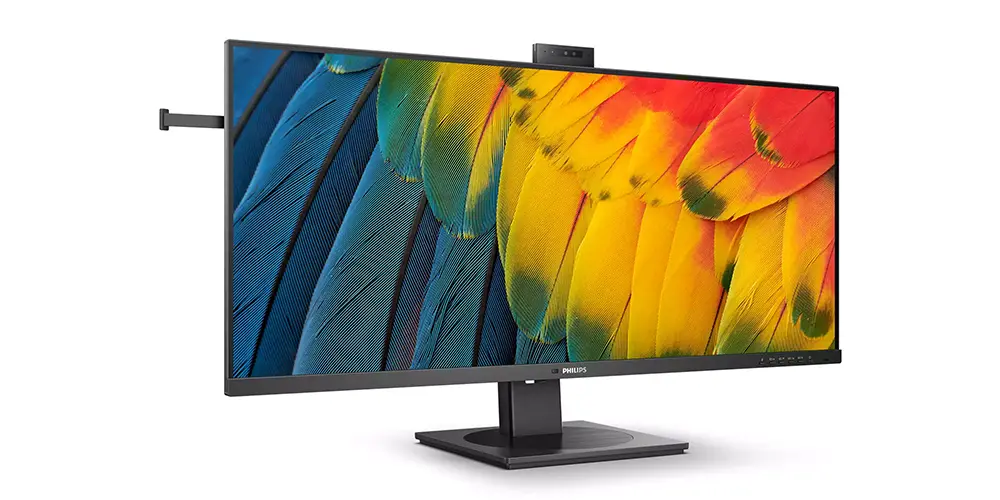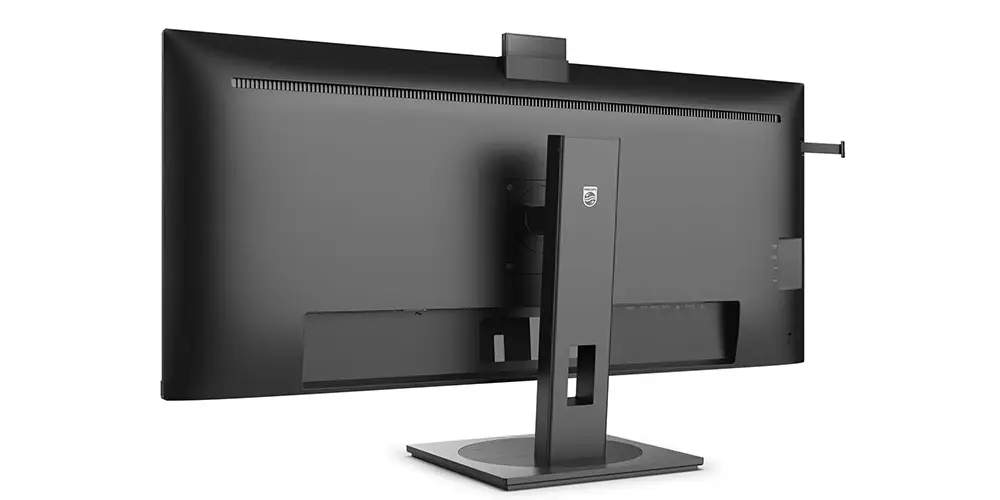The Philips 40B1U5601H is a large 40-inch monitor that stands out for its equipment. In addition to the large screen, it has two USB-C ports with 100 W, four USB 3.2 ports, a Gigabit Ethernet port, a keyboard and mouse switch (KVM) and a Windows Hello-compatible webcam.
Pros
- Image quality
- Frequency of 120 Hz
- High quality finish
- Low power consumption
- 100W USB-C port
- Integrated keyboard and mouse (KVM) switch
- Windows Hello compatible webcam
Cons
- No FreeSync / G-Sync compatibility
- KVM only for USB-C inputs

Overview
The Philips 40B1U5601H monitor features a 40-inch (102cm) widescreen IPS panel with an Ultra Wide Quad HD resolution of 3440 x 1440 px. It supports a refresh rate of 120 Hz but is not FreeSync compatible. The manufacturer claims a maximum brightness of 300 cd/m², a contrast of 1200:1, a response time of 4 ms and viewing angles of 178° in both directions. The Philips 40B1U5601H stands out above all for its connectivity and functionality. The Philips 40B1U5601H offers two 100W USB-C ports – perfect for charging a laptop – four regular USB ports, a Gigabit Ethernet port, a DisplayPort output for daisy-chaining a second monitor, a 5MP webcam with microphone for unlocking via Windows Hello, a brightness sensor, a presence sensor, a headphone holder and a keyboard/mouse (KVM) switch that allows you to use a single keyboard/mouse combo on two different computers.

Ergonomics
The Philips 40B1U5601H monitor is not eccentric but relatively sober. It has good quality black plastic and a screen surround without a plastic edge.
It has a brightness and presence sensor on the front of the monitor, right next to the logo. A microphone and an LED indicator back up the 5MP webcam. It is compatible with Windows Hello to unlock the computer via facial recognition.
The monitor has a height adjustment of 15 cm and a tilt adjustment between -5° and +30°.
The rear of the chassis is made entirely of good quality matt black plastic. The connections are oriented perpendicularly. Once the stand is removed, the screen is compatible with VESA 100 x 100 mm mounts. A reasonably basic cable channel at the base of the arm allows all the wires to be grouped.
The connectivity consists of an HDMI input, a DisplayPort, two USB-C (KVM compatible) that can supply 100W, a Gigabit Ethernet port, a DisplayPort output for daisy-chaining a second display and two USB ports. There are also two USB ports, a USB-C port (15 W) and an audio output on edge. The display also has two 5W speakers, which are far from exceptional but are useful for system sounds and short videos. The display supports Picture-In-Picture and Picture-by-Picture modes. It also has a built-in keyboard/mouse (KVM) switch. Connect your keyboard and mouse to the display, and it will control the source you use (USB-C inputs only). The USB-C to USB-C cable supplied with the monitor allows you to charge a laptop, use the USB 3.0 ports to connect a keyboard and mouse, for example, and send the video signal to the display. In short, a single cable is needed to turn the monitor into a docking station.
The USB-C ports can supply 100 W, but not simultaneously. This means that they can be used to charge almost any laptop on the market, even powerful ones like the 14/16-inch MacBook Pro, which has a 96-watt power supply. Only owners of the more powerful models with a 140W power supply may be bothered. It works perfectly, and the power supply is only used to its full capacity during heavy loads. In the case of the 16-inch MacBook Pro, for example, the battery takes over if the power demand is too high.
Navigating the OSD (On-Screen Display) menus with five buttons on the front panel. They could be more practical and lead to frequent operating errors. It’s a shame that the manufacturer didn’t opt for a joystick, as it does on some of its models (Philips 345E2AE). The menus are clear enough and offer a lot of settings.

Responsiveness
The Philips 40B1U5601H does not use PWM (Pulse Width Modulation) to adjust brightness, so it is flicker-free and won’t cause headaches for those sensitive to flicker. Philips also offers a blue light reduction mode in software via the OSD.
This monitor does not support FreeSync or G-Sync. It is best to have a graphics card that can display 120 frames per second in native definition (3440 x 1440 px) consistently. It doesn’t matter for office use, even though 120 Hz brings a very pleasant fluidity to the interface.
We measured the dwell time at 12 ms with the overdrive set to “faster”. The highest (“fastest”) setting results in a slight reverse ghosting effect. Despite having a 120 Hz panel, this monitor is not the most responsive. In comparison, the Iiyama Prolite XCB3494WQSN monitor has a remanence time of only 8.5 ms. In contrast, the best performing VA models, such as the Samsung Odyssey G7 27 or 49G9, have a remanence time of only 4.5 ms. Among the IPS models, only the Asus VG279QM, with its 240 Hz Full HD IPS panel, does better with only 4 ms. The display delay is measured at 9.5 ms (at 60 Hz), so there is no lag between the action of the mouse, keyboard or joystick and its impact on the screen.

Conclusion
The Philips 40B1U5601H is a large monitor that is pleasant to use daily. It delivers a perfectly calibrated image, which adapts to the ambient light. In addition, it can be used as a real docking station thanks to its USB-C ports (100 W), its integrated Gigabit Ethernet port and its numerous USB ports. The Windows Hello-compatible webcam and its ergonomics are also a significant plus. This monitor, which is not designed for gaming (average response time and lack of FreeSync), would have deserved a better resolution.

